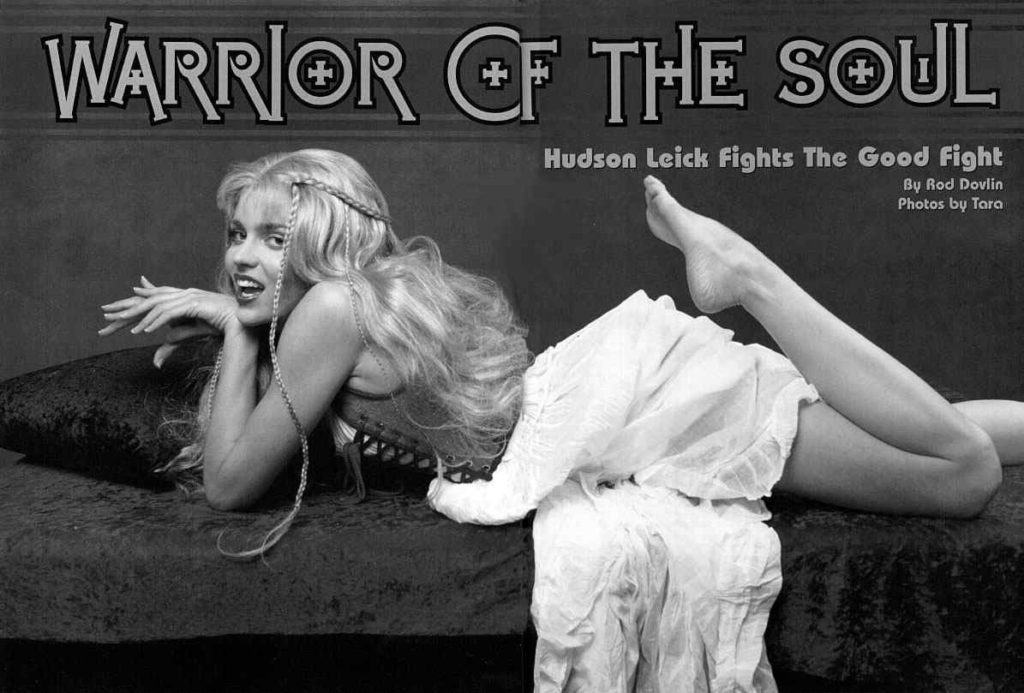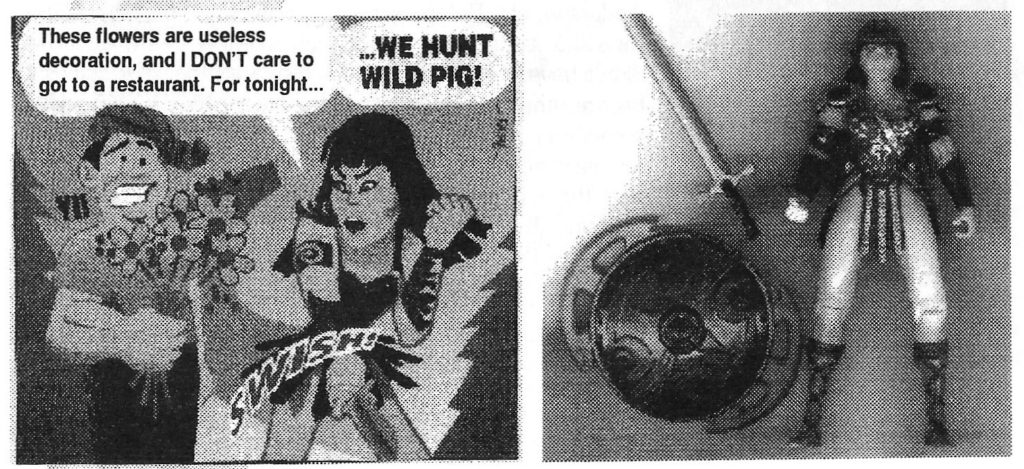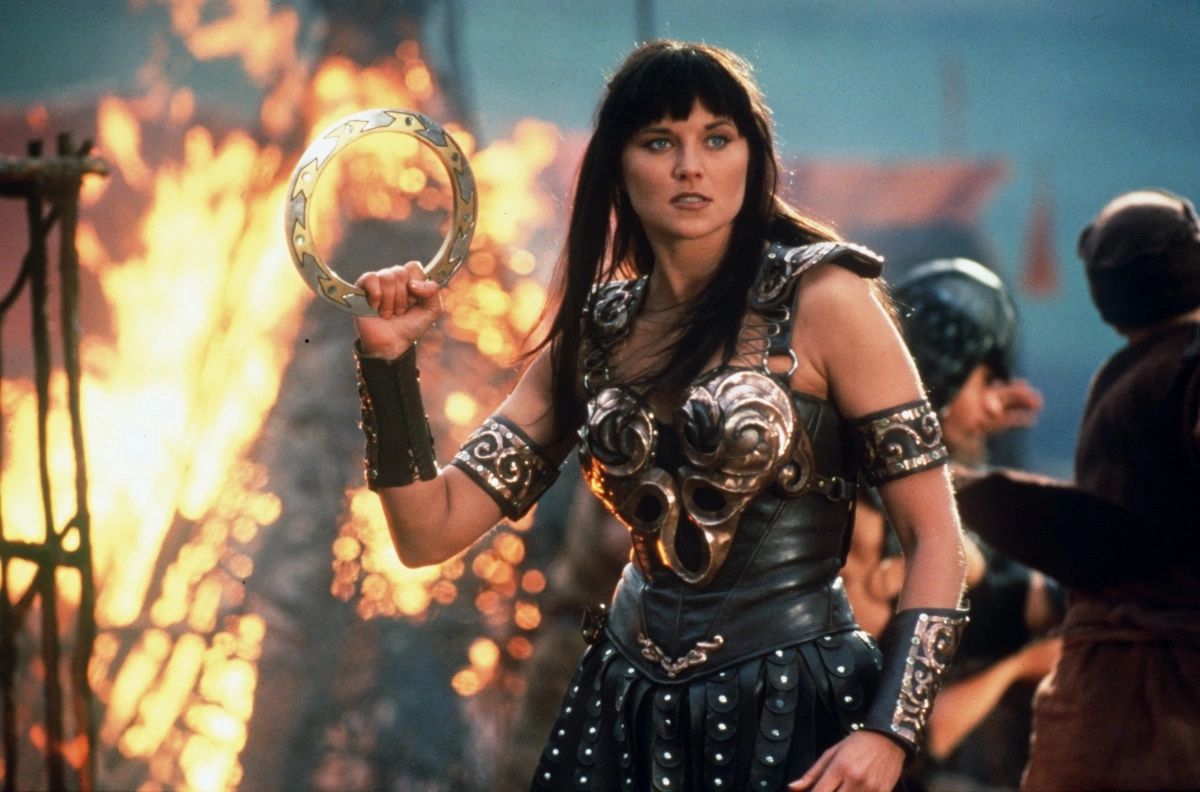Trash TV #2: In Bed With Callisto
The Supplemental Delights of ‘Xena: Warrior Princess’
Back in the mid-80’s, there was a distinct sub-genre of films known as “barbarian bimbo”. These had titles like Warrior Queen and starred Sybil Danning, Lana Clarkson or some similarly formidable creature, who looked good wielding an F-sized sword. Watching Xena – Warrior Princess brings it flooding back: dodgy accents, small outfits pretending to be armour, and everything else that will warm the heart of a true fan of televisual tack.
Played by the delightfully named Lucy Lawless, Xena began as a spin-off from Sam Raimi’s TV show Hercules. Originally a minor character therein, Xena proved popular enough to merit her own show, also set in the nebulous time and space known as “Ancient Greece” (for which, 1990’s New Zealand is apparently a suitable stand-in). Starting off as a bad girl – in black armour, naturally – leading a horde of bandits, Xena switched to the side of good after rescuing a baby, of necessity swapping to a lighter shade of costume too.
In her own show, she acquired the traditional accessory of heroes: a perky, annoying sidekick, as personified by Monique Gabrielle in Deathstalker II. And, hey, Xena’s sidekick is called Gabrielle! A subtle in-joke? Could be: as a Sam Raimi production, anything’s possible. As far as influences go, they willingly admit HK movies, with Bridgette Bride With White Hair Lin a particular source of inspiration for Xena. Her every facet seems cunningly crafted to provoke awe. Hell, this woman had a spring-loaded cleavage dagger, and when she squeezed her (A-grade) mounds together, it shot out, oh, yessss… Rumours, sadly unfounded, abound of Lawless’s secret past as a porn star.
One interesting sidelight is the alleged subtext. Xena is a dyke icon, remarkably good taste on the part of the lesbian community, compared to their usual choices, such as Jodie Foster, and much panting goes on over the Xena/Gabby relationship, encouraged by unsubtle innuendo from the makers. However, it mostly relies on “meaningful glances”, and much as I enjoy a spot of hot all-girl action, I’m more inclined to point out one eyebrow-raising thing about ‘Hercules’: the quantity of young guys in skimpy leather outfits, hanging round the plot for no readily apparent reason.
Far better, of course, to have young women in skimpy leather outfits, and on her own, Lucy Lawless would be enough. Yet she is not the top-rated beauty on the show…

“Love is just a trick nature plays to get us to reproduce. I want no part of it”.
Every good show needs a good villain: Batman had the Joker, ST:TNG had the Borg, and Xena has Callisto. One of the strengths of Xena: Warrior Princess is its ability to get good performances from unknowns. Lucy Lawless had done little of note before, and the same applies to Hudson Leick (“like”), who plays Callisto: despite a minimal resume, she creates perhaps the most memorably evil TV creation of the 1990’s.
Her history dates back quite a while, to when Xena was still a bad girl herself. Her army rampaged through Callisto’s village, and while Xena’s rules were strictly Leon-esque i.e. “no women, no kids”, Callisto’s family were burnt alive. After growing up, Callisto dedicated her life to Xena’s extermination: starting with her reputation, moving on to her friends, and only then killing the warrior princess herself.
Callisto has even had a sword to Xena’s throat, and let her go, since she wants first to utterly destroy all Xena loves. Not the least of which is Gabrielle… Without wishing to give away too much plot, in the second series Callisto succeeds in changing the pacifistic Gabrielle into a revenge-driven harpy of rage. This feat forever endeared her to those of us who share Callisto’s opinion of Xena’s sidekick as an “irritating blonde”.
Such devotion to duty helps explain Callisto’s appeal — apart from the fact that Leick is a total babe! With cheekbones so sharp you could use them to cut glass, the blonde badness of Callisto does the unthinkable, and makes Xena look dowdy in comparison. Leick’s slimness is also the subject of some bitching, especially from fans of the relatively chubby Xena: but, hey, ‘Callisto: Warrior Anorexic’ has a nice feel to it.
They say the devil has all the best tunes, and in this show, she also get most of the best lines, as Callisto delights in playing mind-games with Xena, smearing her with bloody memories from the past. The quote above is an example of her philosophy, though it sadly puts paid to idle subtext-esque fantasies of Xena and Callisto, and never mind Xena and Gabrielle! But Leick doesn’t even need spectacularly excessive dialogue (“You created a monster with integrity, Xena — scary isn’t it?”), not when she can load up an innocent line like ‘Here comes trouble!’ with a deadly, insane edge, and make it ring like chipped crystal.

After one episode in the first series, it was no surprise to anyone when Leick was invited back for more in the second. And such was her success that not even death, smothered in quicksand, could stop her. She moved across to ‘Hercules’ and traded with Zeus’s wife Hera, agreeing to kill Hercules in exchange for life. Needless to say, she didn’t quite manage her side of the deal, but… Callisto is now godlike in the strictest sense, having eaten ambrosia — no, not the rice pudding, the food of the gods. As far as Xena is concerned, the phrase “Here comes trouble!” leaps to mind once more, with regard to the upcoming third season…
Despite her success, it seems unlikely that we will see Callisto in her own show. American TV is not ready for an evil heroine, and somehow the prospect of Callisto turning good like Xena has little appeal. Though this has been kinda seen already: after Lucy Lawless broke her pelvis in an accident with a horse, the makers used a range of tricks to finish filming — one of which was “Xena taking over Callisto’s body”. The result was… well, it’s an interesting place to visit, but you wouldn’t want to live there. Instead, to see Callisto in full evil flow is a wondrous experience: truly nothing succeeds like excess.
Some reckon the camera should merely spend 50 minutes panning smoothly up and down the firm, lithe bodies of Callisto and Xena, without unnecessary plot interference. Yet the makers insist on inserting stories and, worse still, making them imaginative and inventive. It’d be easy for the series to degenerate into a repetitive saga of “Kill the baddies, save the village”; that it doesn’t is a pleasant shock, even if it’s by wholesale plundering outside the Greek mythos, including Charles Dickens and Indiana Jones.
The characters, too, are often unexpected: Charon, ferryman of the dead, as a stand-up comic, or Sam Raimi’s brother Ted as an ineffectual wimp, and Bruce Campbell turns up as Autolycus, the king of thieves. But it’s Lawless herself who’s the biggest revelation, bringing a surprising amount of depth and colour to a role that could also have slid into the banal and cliched. In the episode Warrior… Princess… Tramp, she plays three totally different characters, and they are all perfectly believable. About the only weak link is Renee O’Connor; her attempts to bring variety to Gabrielle’s character are usually squirm-inducingly bad, and stand out all the more because virtually everyone else in the series is so good in their roles.

Xena has succeeded where other female action heroines have been critical and commercial failures: Lori Petty, Pamela Anderson, etc. Before Xena, you have to go back to ‘Aliens’ for a kick-ass babe who made such an impact. And Sigourney didn’t have pop-up breasts. It’s become the biggest syndicated show in America, providing something for everyone: women can appreciate the strong female characters, men can appreciate the, er, strong females. It’s no surprise that it’s one of C5’s top ten rated shows — though, let’s face it, anything with an audience in double figures would probably qualify there…
